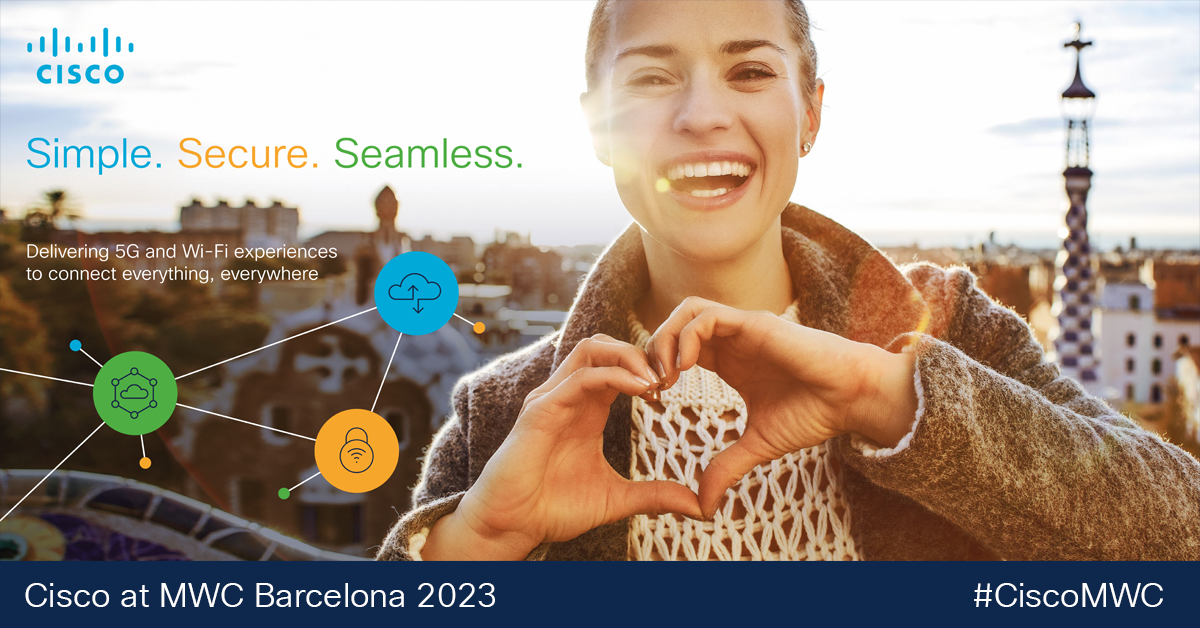OpenRoaming is a new way to connect your mobile devices to a Wi-Fi network – automatically. Say goodbye to finding and typing Wi-Fi passwords, and to disruptive pop-up screens you have to click through. With OpenRoaming, your mobile device can connect quickly, automatically, and securely to a trusted Wi-Fi network.
Mobile World Congress attendees in Barcelona were some of the first people to try out seamless OpenRoaming wireless connectivity, and many didn’t even know it. The new connection technology allows people to join wireless networks across enterprise, consumer, and public markets. The Cisco-led federation includes several trusted identity providers, and allows users to join any network that is part of the federation.
See also: How Wi-Fi 6 will change the way you connect in big venues
For example, if you’re in an airport trying to connect to Wi-Fi, you may have to look for the Wi-Fi network name (the SSID), wait for a pop-up on your device, and then accept terms and conditions. And this might happen multiple times while you’re in the airport. OpenRoaming eliminates that hassle. It creates a link between identity providers, service providers, and enterprises to safely share credentials and access networks.
Refining the model
Some may recognize this kind of technology as similar to Passpoint, a method to streamline network access. Passpoint allows you to use your existing cellular device ID to access a Wi-Fi network. OpenRoaming allows enterprises and businesses to provide identity credentials in much the same way as cellular providers do Passpoint.
“If you look at this from a business standpoint, roaming relationships represent business relationships,” says Cisco Director of Wireless Product Management Matt MacPherson, “So if we're extending roaming relationships to the enterprise and to public sector, we're opening those bounds of business relationships. Whether it be for retail or education or finance, the ability to automatically connect people to the network becomes really strategic to their business. If we can connect more people more easily and securely, that's OpenRoaming.”
Wireless in Barcelona
Conference-goers in Barcelona were part of the OpenRoaming pilot program, where Samsung was the identity provider and Mobile World Congress, as a venue and access provider, chose to honor it. Attendees never had to sign onto the network twice, meaning they were connected throughout the venue. The technology even extended to local train stations and the airport.
The venue, Fira de Barcelona, has a network run by a partner called Unitronics, while the city uses Cellnex. The train station is run by the transit authority and the airport uses their IT department—but even with all of these different organizations, users got one unified experience. And Cisco received the best kind of feedback.
See also: Wi-Fi networking is finally getting interesting
“The great thing about the feedback at Mobile World Congress was—in most cases it was nonexistent,” says VP of Wireless Product Management Greg Dorai, “Which means that it is so smooth that people didn't even notice. Nobody is going to say, ‘I'm on the network’—that's not today's world. They're just on the network. 3,000 people got on the network and they didn't even notice.”
Cisco runs the Federation
Cisco is leading the charge for OpenRoaming. The company is organizing the federation that helps match identity providers, like Samsung and Boingo, with Wi-Fi access providers. The OpenRoaming Federation shares the user credentials between the different providers. Once a user signs in to an identity provider, access providers will allow those identities to automatically join their networks, so users can to get online automatically.
And Cisco makes sure that this process is secure. An OpenRoaming partner, like the Fira de Barcelona convention center or any other venue, can choose how to use OpenRoaming. For example, they may choose to only give limited network access to devices using a specific carrier identity.
OpenRoaming solves your problems
Imagine how OpenRoaming can change the game for consumers in places like airports, retail stores, arenas, and more. For end users, OpenRoaming means a better mobile experience. Plus, making moving from LTE to Wi-Fi easier also means saving data. It’s a secure connection to Wi-Fi anywhere and anytime.
“This should work very nicely as we hand off connections between cellular and Wi-Fi in both directions,” says Farpoint Group Principal Craig Mathias, “It will make both networks transparent all the time. OpenRoaming allows encrypted connection, so end users will feel secure in using the network. Venue owners can be actively connected to the network and can interact with the retailer as a customer. If consumers go to a home superstore looking for screws or to a clothing store looking for a specific shirt— they could just ask and not worry about what network you're connected to. It makes networking transparent for the end user.”
Shoppers can automatically onboard to a retail store and receive notifications for discounts or assistance. Retailers can get back their data ownership, with the control and ability to edit, share, and restrict access to the data. Businesses can use OpenRoaming for enterprise guest access, which will allow easy collaboration across companies, and remove the finicky minutes of guest onboarding time.
“We're allowing all those different credentials to be used through a common federation so that we drive the likelihood of you having the right credential for the access network that you're on,” says MacPherson, “And that's the goal no matter where you are—to be able to automatically and securely connect to that access network.”
What’s next?
Mathias says that OpenRoaming will mature by the end of 2019. As of right now, pilot trials are taking place at events like Mobile World Congress and at the upcoming Cisco Live in San Diego.
“Think of this as the future of authentication to a very great degree,” says Mathias,
“It's going to play a major role in how users connect to networks. In general, it may be broadly influential beyond Wi-Fi and into the IoT world.”
###
We welcome the re-use, republication, and distribution of "The Network" content. Please credit us with the following information: Used with the permission of http://thenetwork.cisco.com/.




